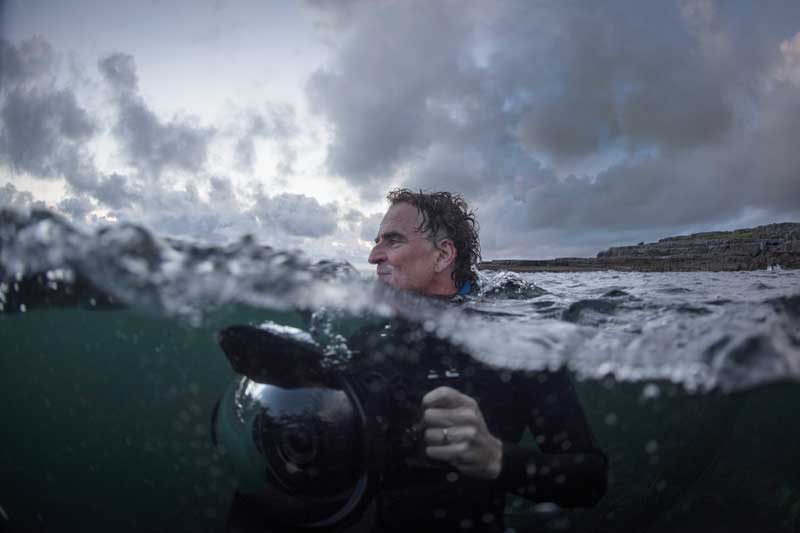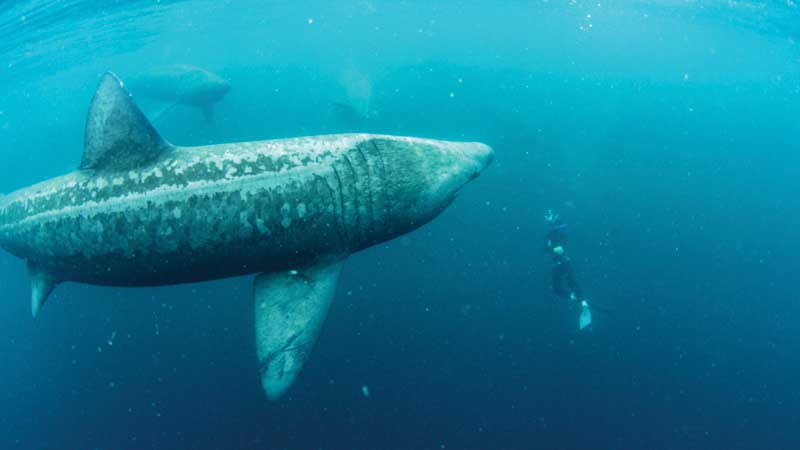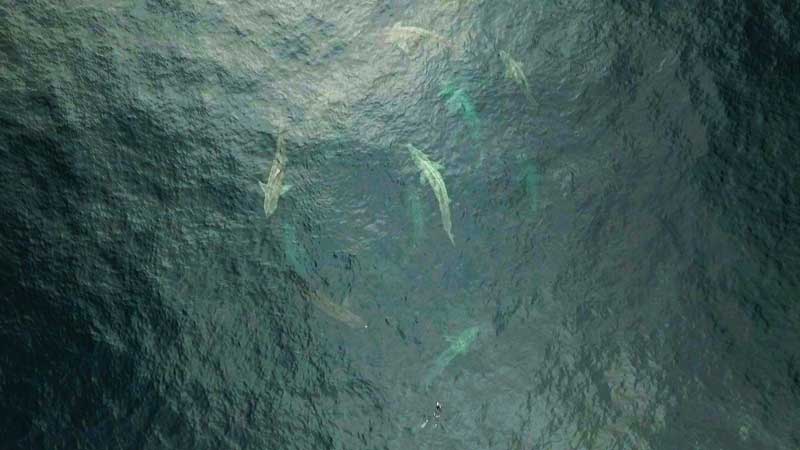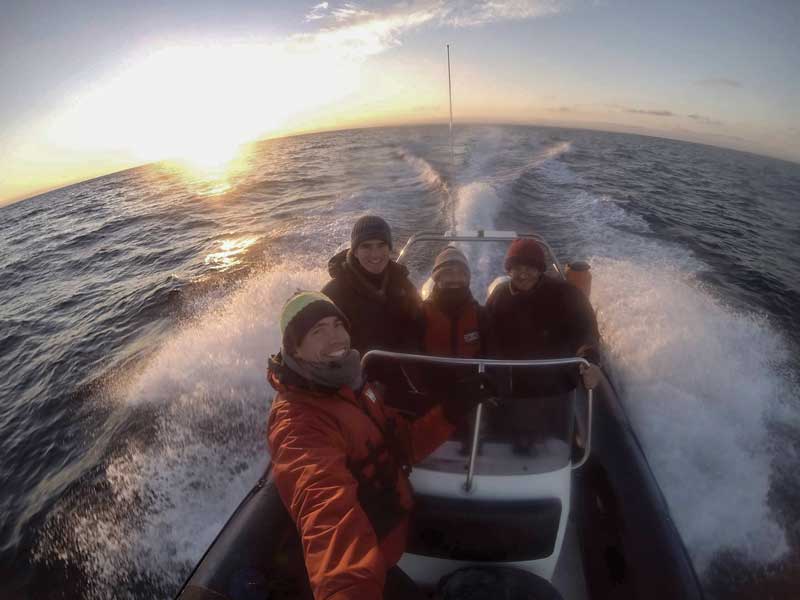Basking in the glory of Ireland’s Atlantic
Being in the midst of circling basking sharks is a rare occurrence, so did this underwater filmmaker witness a unique courtship event?
Words by Ken O’Sullivan

What an odd thing it is to want to swim with a shark in the sea. We humans, we’re usually close to the surface and looking down, into darkness, considering what lurks below.
All our instinctual fears tell us this might not be good.
But it’s an interest I’ve developed over the years and so I’ve spent a fair bit of time trying to film sharks in the North Atlantic waters around Ireland. I’ve managed to film basking and blue sharks, as well as the smaller tope shark and various dogfish species, our smallest sharks. I’ve made various attempts to document makos and angel sharks, always unsuccessfully. I’ve seen flashes of the hugely elusive porbeagle, Ireland’s largest predatory shark, slightly smaller than (though unnervingly similar in appearance to) a great white, but I haven’t yet managed to get close enough to a porbeagle to film one.
I used to be scared—and you should be respectfully cautious encountering any shark. The ocean is an alien environment for humans and most sharks haven’t seen many of us, so they’re perhaps not sure how to respond, and so it’s important to know how to behave around these animals, to understand their behaviour and, most importantly, to know when to leave them alone.
When I first tried to film basking sharks, it took a while to realize that finning after them whilst pushing a camera is a bit like trying to pedal a penny-farthing bicycle up a steep hill. Like all wild animals, in my experience, if they’re moving away from you it’s best to let them go.
With a bit of help from my old friend John Boyle, who spent years filming basking sharks in Cornwall UK, and from my own observations, I realized that you need to spend enough time watching their paths as they repeatedly trawl the same area, so as to eventually judge where they’ll be, and then sit still on that line.
Basking sharks appear in Irish inshore waters in spring to feed on zooplankton, a collection of tiny animals and larvae that feed on phytoplankton, the tiny plants that bloom in the sunlight of longer spring days. This means the sharks are chasing ‘seams’ of zooplankton that often run with tidal currents. Their snouts and part of their heads are covered with arrays of sensors known as ampullae of Lorenzini, gel-filled pores that can detect the bioelectric fields which all organisms produce. They can track the movements of zooplankton —even, amazingly—through their nightly migration between deep and surface waters. So if these sharks can detect the movements of 1/16th of an inch (1mm)-sized pieces of plankton, a human will need to stay very still in order not to spook them.

Ken O’Sullivan is an author, documentary filmmaker and ocean conservationist based in Lahinch on Ireland’s North Atlantic coast. In 2006 he founded Sea Fever Productions and among his credits are four ocean natural history TV series, as well as work for the BBC Natural History Unit and other international broadcasters, culminating in 2018’s critically acclaimed and multi-award winning series Ireland’s Deep Atlantic.
Earlier encounters
In the spring tides of early May 2012, I spent several days filming sharks at the south end of the Cliffs of Moher, off Ireland’s Atlantic coast. Some of the biggest tides of the year occur at that point, almost a 17-foot (5m) tidal difference, and because this is during the spring plankton bloom, really special things can happen here. On the third day, as the tide was at its peak and flowing fastest around the ‘corner’ of the cliffs, and the surface water was pinkish in colour from the density of plankton. It was like a kind of pasta soup, with big hollow pieces, some maybe half an inch (1cm) wide; you felt as though you could scoop up a saucepanful and cook them. The basking sharks, preoccupied with this bonanza, seemed to lose all caution in my presence and regularly swam within a few feet of my camera.
Then a huge shoal of juvenile mackerel appeared below me in the water, drawn by the same bounty, their rich green and silvery pigmentation pulsing and flashing as maybe ten thousand of them flicked and swam in perfect synchronized formation, like an underwater murmuration
of starlings.
After five or so hours of this, we decided to drive the six miles (10km) back to our harbour in Liscannor to get some sandwiches and boat fuel. On our return, perhaps forty minutes later, the sharks and mackerel were all gone. Vanished. The climactic stage of tide and consequent feeding had passed.

Try a bit longer
In 2016 we were in full production for Ireland’s Deep Atlantic, an ambitious natural history TV series about my journeys out into the deep, open waters of the North Atlantic in search of whales, sharks, and any other creatures. I was hopeful that we would find certain whale species, but in terms of sharks, it was a real unknown. I know many of the underwater cameramen around Europe, but none had been in these offshore waters to the west of Ireland and out to the edge of the continental shelf. Shark scientists would smile when I’d ask what I might find in offshore waters. Blue sharks were obvious, but after that, hmm…. No one had spent the time looking for sharks in these areas; I guess there are easier places to find large ocean animals!
I’ve spent ten years pulling RIBs (rigid inflatable boats) to remote parts of Ireland, days at a time searching for whales and sharks in places like the Saltee Islands off Wexford, the coastal waters of Waterford, West Cork, and the Blasket Islands off West Kerry, but for a few years now, I’d been watching a section of the ocean off Clare, where I actually live. I’d seen signs from shore, flocks of birds diving perhaps 10-15 miles (16-24 km) out from the shore. While sailing home from a two-week expedition on the open Atlantic on board a research ship, I spotted definite bait-ball activity, west of Mutton Island, a few of miles west of Clare. But after two weeks at sea and with our home port of Galway almost in sight, it would have been somewhat awkward asking the captain and thirty-five other sailors to stop the ship so that I could wait to spot a whale blow. On a sailing trip that summer, I’d seen a single large whale blow in the midst of lots of birds; again we were in a hurry for our port and couldn’t stop, but there was clearly a fertile area out there somewhere.
So finally in mid-August we ventured about ten miles (16km) offshore in our RIB where, given the above activity, I felt there could be a coastal front. This is a phenomenon where the thermocline, which is the division between warm surface water and much colder deeper water, actually reaches the surface waters and hence causes an upwelling of nutrient-rich water. So we drove transects in the RIB: one mile north, then two miles west; one south, then east; and north again etc.; for about five hours, but apart from a flurry of excitement with a few common dolphins and some storm petrels, there were no animals to be seen. But we love being at sea, and with good friends the time flies, just three of us, big wave surfer Peter Conroy driving the RIB and drone cameraman Kev L. Smith.
As is so usual in these scenarios, just as we were thinking of leaving, someone said, “Let’s try a bit longer.” The wind had dropped and the sky darkened, making a deadened, contrast-less, surreal scene. We saw some Minke whales, and though I repeatedly swam about trying to get in their paths, perhaps four or five hundred yards (360-460m) from the RIB, it was futile; back at the boat the lads were hysterical laughing, telling me that the Minkes had kept swimming under the RIB. I gave up.
Turning for home, I saw some large fins travelling slowly in the water, the unmistakable sideways finning of a basking shark, possibly even two. We killed the engine and I slipped into the water, swimming the last couple of hundred yards/metres. The sea was thick with plankton, and I thought, “I know what’s going on here, sure I’ll get a couple of shots at least.”

Shark circle
The sharks swam past me, first a couple, then more, and then more again; all huge animals, perhaps 25 feet (8m) long, three layers deep and moving almost in formation. It was like a train in a scene from a children’s animation film, in which seemingly endless carriages bank around and around an unrealistically long curve in the landscape. When would it pass? And after a bit it dawned on me: the sharks were circling. The plankton was so thick I couldn’t see the other side of what was probably a 20-yard (18m)-wide circle. Round and round they went: this was unlike anything I’d ever encountered; I’d never even seen a basking shark underwater without its mouth open; their heads looked so different this way.
As a cameraman, your first instinct is to shoot as well as you can and document the scene; in the water you might get one chance to film a passing shark or whale, a few short seconds, and your focus, exposure, composition, etc. better all be good. But this was the most improbable of scenes. I’d never been so close to so many basking sharks. As they drifted gracefully through the water I could see all the exquisite detail of the pigmentation on their skin, their moving, inquisitive eyes, and most of the animals bearing scars from cookiecutter shark bites. (These are Tasmanian Devil-like animals that rise from the deep, take a cookie-sized bite and disappear again: what a way to make a living!)
The basking sharks kept coming, all with lamprey eels—sometimes several—attached mostly behind their pelvic fins, near the reproductive organs. At times it was difficult to tell the males’ claspers apart from the eels, but this clearly was the sheltered spot favoured by the eels—less drag, I guess, though not great for the sharks.
As staggering as it was to witness this scene, it was only later, when viewing Kev’s drone shots, that we realized the uniqueness of the gathering. Kev is an amazing, skilled, brave cameraman. I asked him to come into the water and try to get some underwater shots of me with the sharks. It was only later in a question and answer session at a college screening of the documentary, that I realized what I had actually asked him to do. Someone asked who’d filmed me. Kev put his hand up, “Yeah I’d never swum in water that deep or so far offshore or with a shark, never mind sixteen of them. Ken’s going, ‘Come on, come on, get closer, you have to shoot the detail’ and I’m looking at these eight-metre [26ft] sharks, and my swim momentum is taking me right into their line. I’m trying to back up and he’s going, ‘Come in closer!’” The crowd was in hysterics and I felt like a right selfish eejit.
I‘d noticed there was an even mix of males and females and that the males’ claspers, where they hold their sperm, were swollen, but I still hadn’t quite figured out what the sharks were doing: could it be courtship? Kev went researching and found something to suggest it could be a mating or pre-mating ritual. I did some more reading and emailed Professor David Simms in the UK, the world expert on basking sharks, who replied in a matter of minutes. This was to become an important moment in our understanding of the animals.
Researchers had seen the circling activity from an aircraft in Canada in 1998, and shark hunters had reported similar activity off Cornwall in the 1940s and ’50s, but as no one had been in the water and hence been able to identify the sexes, this was likely the first documented instance of basking shark courtship behaviour. Of course, without seeing actual copulation, we can never be a 100 per cent sure. I could have stayed longer in the water though I felt the half hour I was with the sharks was enough, and disturbing them was the last thing I’d want to do, but it’s difficult to think of another reason for the shark’s behaviour. On viewing the video footage, Simms was hugely enthusiastic and set about writing a research paper on the activity. Later that summer, some scuba divers photographed similar activity just north of where we were, and in a similar water depth, so we can now say that this area is an important habitat for basking sharks, but huge gaps remain in our knowledge of these animals and consequently our ability to protect them.

Need for conservation
Basking sharks were hunted for at least two hundred years in Ireland: their livers, which take up almost a third of their body, made a highly-valued and versatile oil. Coastal communities hunted them and it was said that their oil could light a whole village for a year and indeed there was a time when the streets of Dublin and Cork were lit with basking-shark oil. In later times their oil was used in cosmetics and even aeronautical engineering, as its consistency remains the same under fluctuating pressure levels when other oils coagulate.
9,000 sharks were killed in the Achill Island station alone between 1940 and 1954, and it appears Norwegian boats hunted them in EU and Irish waters until as recently as 2006. The basking shark of the northeast Atlantic is listed as Vulnerable in the International Union for Conservation of Nature (IUCN) Red List and is included in the OSPAR list of threatened or declining species and in Appendix II of the Convention on International Trade in Endangered Species (CITES).
In Ireland wild animals are protected under the 1976 Wildlife Act, but for some odd reason, this act excludes marine fish and invertebrates, meaning that legally these creatures are not classified as ‘wildlife’. Basking sharks being fish (the second-largest in the world after whale sharks) are therefore a legally unprotected species in Irish waters, although it is illegal to land them, and under EU law it is forbidden to target-fish them. Clearly, much more needs to be done to conserve basking sharks in Ireland.
Stories From The Deep – Ken O’ Sullivan, www.gillbooks.ie
Stories from the Deep is an exploration of Ireland’s ocean waters through narrative and poetry. From encounters with blue whales and the basking sharks talked about in this artilce, to our shared sense of place. This is an eloquent tribute to the enduring beauty of our natural heritage. Ken has had a remarkable career exploring North Atlantic waters and is sharing them in this unique book. Spun from the author’s first-hand experience as an underwater cameraman and filmmaker, from memory, natural history, and the culture of Ireland’s coastal communities.







